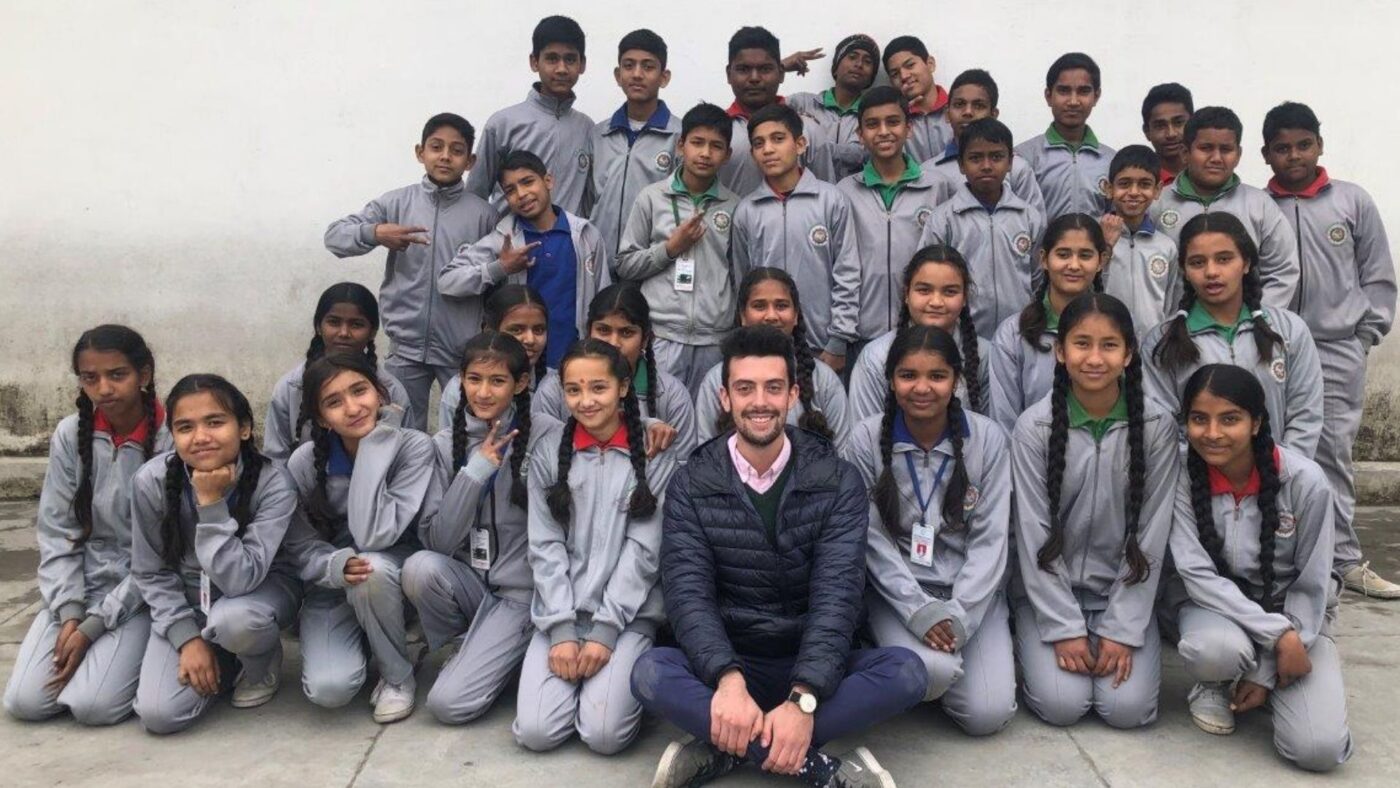The Fulbright-Nehru program opens doors to once-in-a-lifetime global educational opportunities.
January 2020

U.S. Fulbright-Nehru English Teaching Assistant Joshua Jordan (front, center), with his students from the Vivekananda School, Dehradun. Photograph courtesy USIEF
As a college student, Adam Grotsky traveled from the University of Wisconsin in the United States to Varanasi, witnessing firsthand the amazing, life-changing potential of studying halfway around the world. Now, he helps hundreds of American and Indian students create their own priceless and inspiring international experiences each year.
Grotsky is the executive director of the United States-India Educational Foundation (USIEF), a commission that oversees the coveted Fulbright-Nehru Fellowship program. Created in 1950 and expanded in 2008, when India became a full financial partner in the program, the Fulbright-Nehru Fellowship provides study, research and teaching opportunities for Indian citizens in the United States, and for American citizens in India. The ultimate goal? “Promoting mutual understanding between both nations,” says Grotsky.
In India, this means that citizens can apply for opportunities to learn and grow in the United States. Under one Fulbright-Nehru grant, Indian students earn master’s degrees at American institutions in subjects ranging from public health and environmental science to urban planning and women’s studies. Under another grant, the Fulbright-Nehru Doctoral Research Fellowship, students travel to the United States to further their Ph.D. work in history, international law, neuroscience, performing arts and other fields.
There are several other grants to support Indian professors and professionals who wish to learn and teach in the United States, accomplished researchers looking to complete American postdoctoral fellowships, and educators who want to bring lessons from the U.S. higher education system back to their work within India. And the list goes on.
The most recent class of Indian fellows comes from a wide range of backgrounds. Sampreeti Malladi, for instance, is an award-winning dancer and architect from Hyderabad. She has won a grant to bring to life her original project, titled “Dance, Space and the Viewer Connect in Indian Classical Traditions,” at the University of California, Berkeley. Karabi Pathak, a climate expert from Abhayapuri, Assam, has received support to research energy, carbon output and cleaner agricultural production at The Ohio State University. And Kaushal Kishore Chandel of New Delhi has gained sponsorship to look deeply into the policies and strategies of Chinese cyber warfare, at The New School in New York City.
“The Fulbright-Nehru grant enabled me to experience a world-class lab, work with the latest technology and collaborate with pioneers of interactive media,” says New Delhi-based filmmaker Anandana Kapur. A 2017 Fulbright-Nehru Doctoral Research Fellow, she studied at the Massachusetts Institute of Technology. “This helped me gain critical rigor in addressing the changing contours of cinema practice,” says Kapur. “I was also able to screen my films for an international audience.”
The Fulbright-Nehru program has tripled in size in the last 10 years, with a $6.7 million budget. And for Grotsky, that’s money very well spent.
“Through the Fulbright program, thousands of students, scholars, teachers and professionals from across the world engage in meaningful dialogue and develop lasting friendships and partnerships with their peers and counterparts in other countries,” he says. And while always-new innovations in digital communication can certainly make international collaborations possible without the need for visas and airports, technology can never “replace the power and potential of face-to-face interactions,” he continues.
With strong support for Fulbright-Nehru coming from both the American and Indian governments, such powerful international bonds will continue to be forged in the years to come.
“When Indians and Americans study together, conduct joint research and engage in educational exchange activities, they lay the foundation for better relations between the United States and India,” says Grotsky. “Through programs like Fulbright, participants gain an understanding that there’s far more to people than their areas of academic expertise and more to a nation than its politics and policies.” Arguably, he adds, the U.S.-India relationship has been sustained and enhanced over the years by the exchange of students and scholars through initiatives like the Fulbright-Nehru program.
For those interested in creating their own unforgettable educational experiences abroad, hard work, teamwork and curiosity are key. “Fulbright-Nehru Fellowships are for outstanding students, academics and professionals who demonstrate leadership qualities, expertise in their academic discipline and the potential to develop long-lasting professional collaborations and personal contacts with their peers and counterparts around the world,” says Grotsky. “Fulbrighters are ready to share their expertise and knowledge, are open to new ideas and are committed to international engagement.”
Michael Gallant is the founder and chief executive officer of Gallant Music. He lives in New York City.
COMMENTS